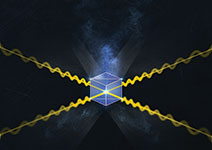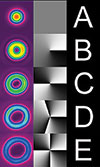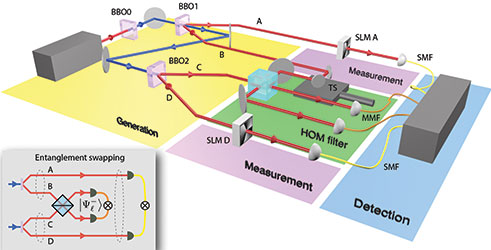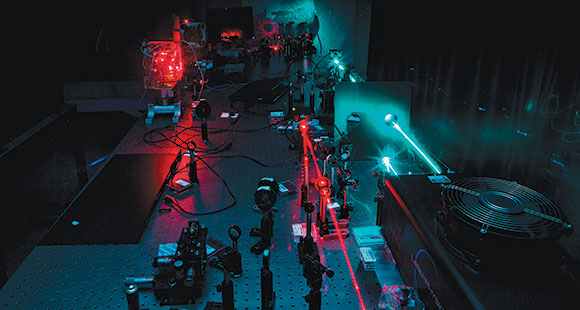Wits researchers demonstrate quantum teleportation of light
15 November 2017
News
Electronics Technology
Quantum communication over long distances is seen as the future of information security and has been demonstrated in free space and fibre with two-dimensional states, recently over distances exceeding 1200 km between satellites. But using only two states reduces the information capacity of the photons, so the link is secure but slow. To make it secure and fast requires a higher-dimensional alphabet, for example, using patterns of light, of which there are an infinite number. One such pattern set is the orbital angular momentum (OAM) of light.
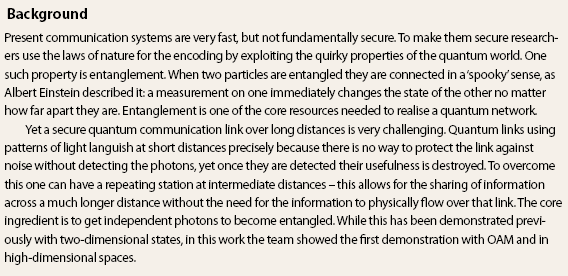
Increased bit rates can be achieved by using OAM as the carrier of information. However, such photon states decay when transmitted over long distances, for example due to mode coupling in fibre or turbulence in free space, thus requiring a way to amplify the signal. Unfortunately, such ‘amplification’ is not allowed in the quantum world, but it is possible to create an analogy, called a quantum repeater, akin to optical fibre repeaters in classical optical networks.
Figure 1. The core element of the quantum repeater is a cube of glass. The researchers put two independent photons in, and as long as they could detect two photons coming out the other side they knew that they could perform entanglement swapping.
An integral part of a quantum repeater is the ability to entangle two photons that have never interacted – a process referred to as entanglement swapping. This is accomplished by interfering two photons from independent entangled pairs, resulting in the remaining two photons becoming entangled. This allows the establishment of entanglement between two distant points without requiring one photon to travel the entire distance, thus reducing the effects of decay and loss. It also means that a line of sight is not necessary between the two places.
Figure 2. An alphabet of OAM modes. OAM modes are sometimes called twisted light as the light appears as a ring with a vortex in the middle. The light can be twisted once, twice, three times and so on to create a high-dimensional alphabet.
An outcome of this is that the information of one photon can be transferred to the other, a process called teleportation. Like in the science fiction series, Star Trek, where people are ‘beamed’ from one place to another, information is teleported from one place to another. If two photons are entangled and the value of one of them is changed, the other one automatically changes too. This happens even though the two photons are never connected and, in fact, are in two completely different places.
Figure 3. A schematic of the experiment. Four photons are created, one pair from each entanglement source (BBO). One from each pair (B and C) are brought together on a beam splitter. When all four photons are measured together one finds that photons A and D, which previously were independent, are now entangled.
In this latest work, the team performed the first experimental demonstration of entanglement swapping and teleportation for orbital angular momentum (OAM) states of light. They showed that quantum correlations could be established between previously independent photons, and that this could be used to send information across a virtual link. Importantly, the scheme is scalable to higher dimensions, paving the way for long-distance quantum communication with high information capacity.
Figure 4. An experiment being conducted in the Structured Light Laboratory at Wits University.
For more information contact Schalk Mouton, Wits University, +27 (0)11 717 1017, [email protected]
Further reading:
From the editor’s desk: Windows 10’s end of support arrives bringing industrial risks
Technews Publishing
News
By the time you read this column, support for non-LTSC editions of Windows 10 will have ended, officially having their last day on 14 October 2025. This means no more security patches, feature updates,
...
Read more...
Electronic News Digest
News
A brief synopsis of current global news relating to the electronic engineering fields with regards to company finances, general company news, and engineering technologies.
Read more...
Correction: Marijana Abt, Rebound Electronics
News
In the August issue of
Dataweek magazine, the article titled ‘Celebrating innovation, leadership, and the next generation’ featured Marijana Abt, senior account manager at Rebound Electronics. Owing
...
Read more...
Trasna and RF Design announce distribution agreement
RF Design
News
Trasna and RF Design have announced a strategic distribution agreement for cellular IoT solutions which will ensure seamless availability of Trasna’s cellular connectivity solutions.
Read more...
Local partnership puts demand-side management to work in South Africa
News
Sensor Networks has partnered with European demand-side management specialist ThermoVault to bring advanced load-shifting capabilities to one of the country’s biggest energy consumers: the household geyser.
Read more...
Hisense SA launches year-long learnership programme for youth
News
Hisense SA’s manufacturing plant in Atlantis recently welcomed 100 young people from the local community, to embark on a year-long learnership and skills development programme.
Read more...
Comtest hosts channel partners
Comtest
News
Comtest, together with FLUKE, recently set the stage for an unforgettable afternoon as they welcomed over 80 Channel Partners to their annual celebration of excellence.
Read more...
RS South Africa and Qhubeka empower learners through the gift of mobility
RS South Africa
News
Through its bicycle donation initiative, 354 bicycles have been distributed to date, empowering students to access education more easily by reducing the physical and economic barriers posed by long daily commutes.
Read more...
Deca and SST announce strategic collaboration
News
The collaboration provides customers with a modular, memory-centric foundation for advanced multi-die architectures.
Read more...
Specialised Exhibitions transitions to new name: Montgomery Group Africa
News
As part of a strategic move to streamline operations, strengthen regional alignment, and support long-term growth, Specialised Exhibitions has transitioned to a new name: Montgomery Group Africa.
Read more...


